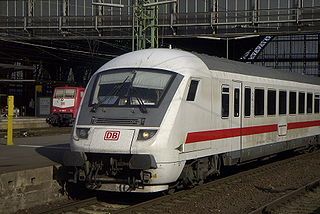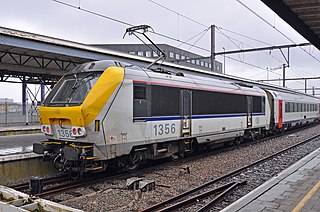
A bilevel car or double-decker coach is a type of rail car that has two levels of passenger accommodation as opposed to one, increasing passenger capacity.

The HSL 2 is a Belgian high-speed rail line between Leuven and Ans and is 66.2 km (41 mi) long, all of it on dedicated high-speed tracks, which began service on 15 December 2002. As part of the Belgian railway network, it is owned, technically operated and maintained by Infrabel.

The Double-deck Coach is a bilevel passenger railcar currently manufactured by Alstom, which acquired Bombardier Transportation in 2021 used by various European railways and Israel Railways. The current generation of double-deck coaches can be run at speeds up to 200 km/h (125 mph). Depending on their configuration, each coach can seat 100 to 150 passengers.

A control car, cab car, control trailer, or driving trailer is a non-powered rail vehicle from which a train can be operated. As dedicated vehicles or regular passenger cars, they have one or two driver compartments with all the controls and gauges required to remotely operate the locomotive, including exterior locomotive equipment such as horns, bells, ploughs, and lights. They also have communications and safety systems such as GSM-R or European Train Control System (ETCS). Control cars enable push-pull operation when located on the end of a train opposite its locomotive by allowing the train to reverse direction at a terminus without moving the locomotive or turning the train around.

Class 11 is part of the large 1980s family of 144 electric locomotives. The family was made up of Classes 11 (12), 12 (12), 21 (60) and 27 (60). Classes 11, 12 and 21 were nearly twice as powerful as Classes 22, 23 and 25 while Class 27 was more than twice as powerful as these 1950s locomotives. This family was heavily influenced by the Class 20² from the mid-1970s. They were very reliable because of the trial and error development of their predecessor. This family came into service with M4 and M5 coaching stock and the AM 80 and AM 86 series of EMUs. This generation was a major modernization of the NMBS/SNCB even if the older M2 coaching stock remained active for more than a decade before being replaced. The only real difference between a Class 11 and a Class 21 was the Class 11 had a transformer inside to allow working under both 3000 V DC in Belgium and 1500 V DC plus Dutch signalling and train protection for working in Holland. Externally they were identical to Classes 12 and 21 aside from the livery and a few minor details.

Class 27 were the first of the Belgian Railways' large 1980s family of 144 electric locomotives. The family was made up of Classes 11 (12), 12 (12), 21 (60) and 27 (60). Classes 11, 12 and 21 were nearly twice as powerful as the preceding classes 22, 23 and 25. Class 27 was more than twice as powerful as these 1950s locomotives. The family was heavily influenced by the Class 202 locomotives built in the mid 1970s. They are very reliable because of the trial and error development of their predecessors. This family came into service with M4 and M5 coaching stock and the AM 80 and AM 86 series of EMUs. This generation was a major modernisation even if the older M2 coaching stock remained active for more than a decade. These four sister classes are visually identical except for a few minor details. Class 11's livery was specific to the Benelux service, which they operated for most of their service lives.

The Class 13 are a type of mixed use 200 km/h (124 mph) multivoltage electric locomotive of type Traxis designed by Alstom in the late 1990s for the Belgian and Luxembourgish railways.

SNCB Class 22 Locomotives were owned by the National Railway Company of Belgium, also known as Nationale Maatschappij der Belgische Spoorwegen or Société Nationale des Chemins de fer Belges, the Belgian national railway operator.

NMBS/SNCB Class 26 are single voltage locomotives that were designed as freight locomotives. They later started working on passenger trains as the electrification was expanded. A batch of five prototypes were delivered in 1964 as Type 126, numbered 126.001-126.005. 20 more were ordered around 1968, to be numbered 126.101-126.120. The final 15 arrived in 1971 and just missed getting six figure fleet numbers, carrying the numbers 2621-2635 from the factory. Actual original numbering turned out to be 126.001-126.005, 126.101-126.120 and 2621-2635. They had nothing in common with earlier Types 122, 123, 125, and 140.

The Belgian Railways Class 18 was a type of electric locomotive operated by NMBS/SNCB of Belgium. They have been displaced from these workings by Thalys electric multiple units and were all retired from service by 1999. They were derived from the French SNCF CC 40100 express passenger locomotives. Their multi-voltage capabilities allowed them to work beyond Belgium's borders, mainly Paris - Brussels/Liège and Oostende - Cologne.

The NMBS/SNCB Class 77 is a class of 4 axle B'B' road switcher diesel hydraulic locomotive designed for shunting and freight work manufactured at the beginning of the 2000s by Vossloh Schienentechnik/Vossloh Locomotives at the Maschinenbau Kiel plant in Kiel, Germany for the National Railway Company of Belgium (SNCB/NMBS).

The NMBS/SNCB Class 28 number series has been brought back into use for 43 Bombardier TRAXX locomotives which have been hired from Angel Trains Cargo for use with B-Cargo, the freight division of NMBS/SNCB, since renamed Lineas. They are numbered in two series - they carry their original numbers, E186 123 to E186 125, and E186 196 to E186 220, and have also been numbered into the SNCB number series, 2801 to 2843.

The SNCB/NMBS HLE 18 are a series of four axle Bo′Bo′ multivoltage electric Siemens EuroSprinter locomotives ordered in two batches of sixty in 2006 and 2008.

Fyra was an international high-speed rail service between the Netherlands and Belgium using the AnsaldoBreda V250 train. The service used the HSL-Zuid and HSL 4 railway lines to connect Amsterdam, Schiphol Airport, Rotterdam, Antwerp and Brussels. Continuous technical difficulties suspended the service, and it was eventually permanently halted due to reliability and safety concerns.

The NMBS/SNCB Type 1 was a class of 4-6-2 steam locomotives built in 1935 and 1938 for working heavy express passenger trains operated by the National Railway Company of Belgium (NMBS/SNCB).

The Belgian State Railways Type 7, later known as the NMBS/SNCB Type 7, was a class of 4-6-0 compound locomotives built between 1921 and 1924.

The class 96 is an electric multiple unit constructed in 1996 for the National Railway Company of Belgium.

The Intercity Nieuwe Generatie, or ICNG is an electric multiple unit trainset of the Dutch Railways. In addition to supplementing the existing intercity rolling stock, it will replace the Bombardier TRAXX locomotives and Intercityrijtuig coaches on the high-speed line between Amsterdam and Belgium. This will provide the connection that was originally planned to be provided by the Fyra service, which was cancelled in 2013.

The AM/MS08series is a three-part electric multiple unit of the Siemens type Desiro Main Line, a so-called lightweight train with a low-floor section for regional passenger transport and local passenger transport for the National Railway Company of Belgium(SNCB/NMBS). They were originally intended for the Brussels Regional Express Network but have been deployed on L (local), S-train and IC (InterCity) train services across Belgium.

The M7 cars are a series of bilevel rail cars of the National Railway Company of Belgium (SNCB). Developed from the M6 cars they are built by Bombardier Transportation and Alstom. The first car was delivered in September 2018. The M7 coaches are mainly intended as intercity stock, they will completely replace the M4 and partly replace the M5. Different types of M7 cars can be coupled to form loco-hauled or self-propelled trains similar to the German Twindexx Vario.





















